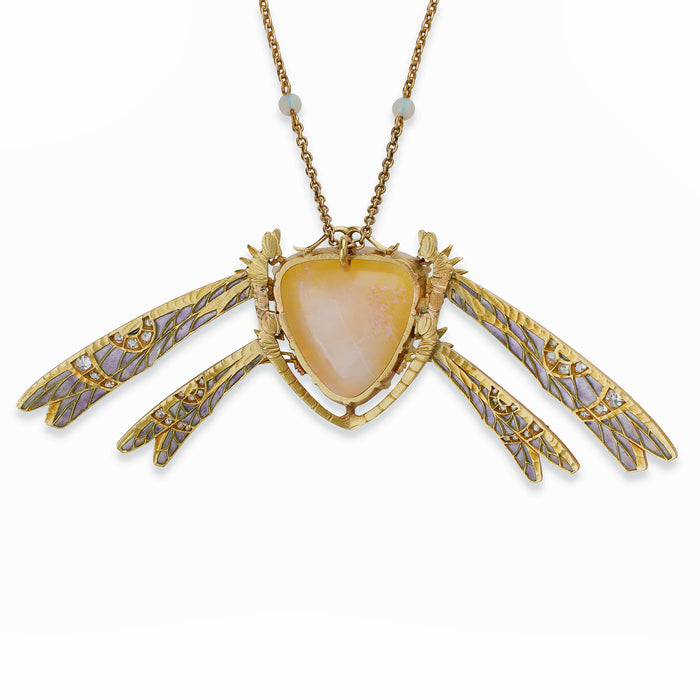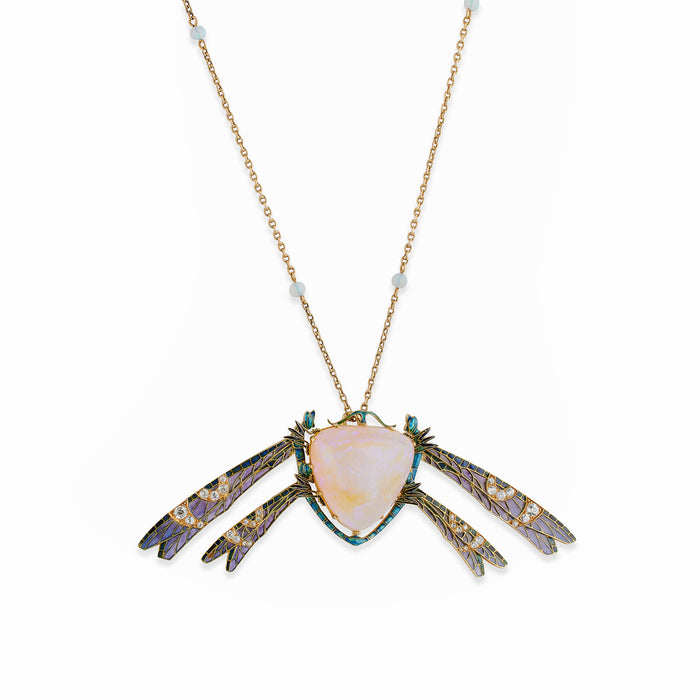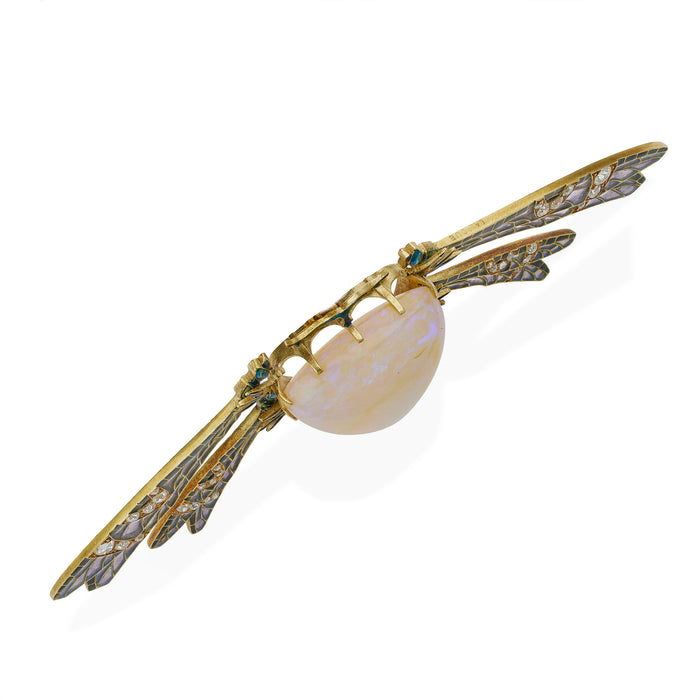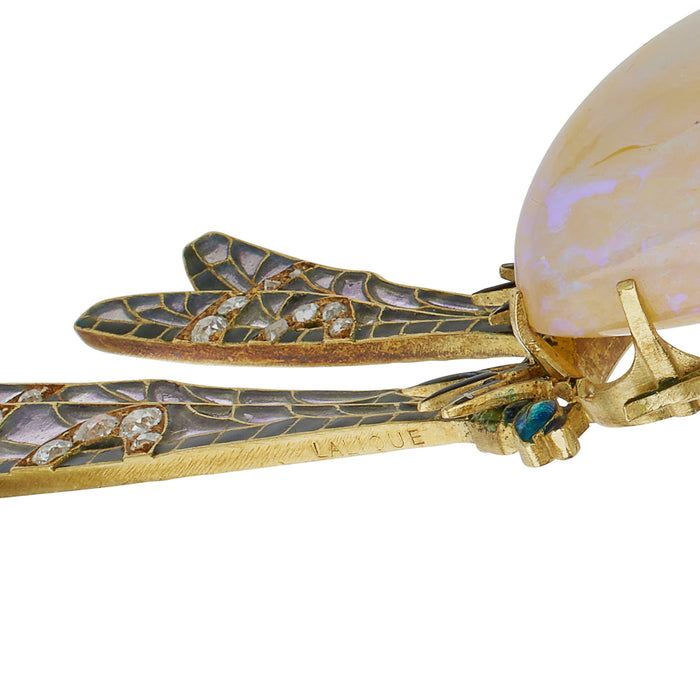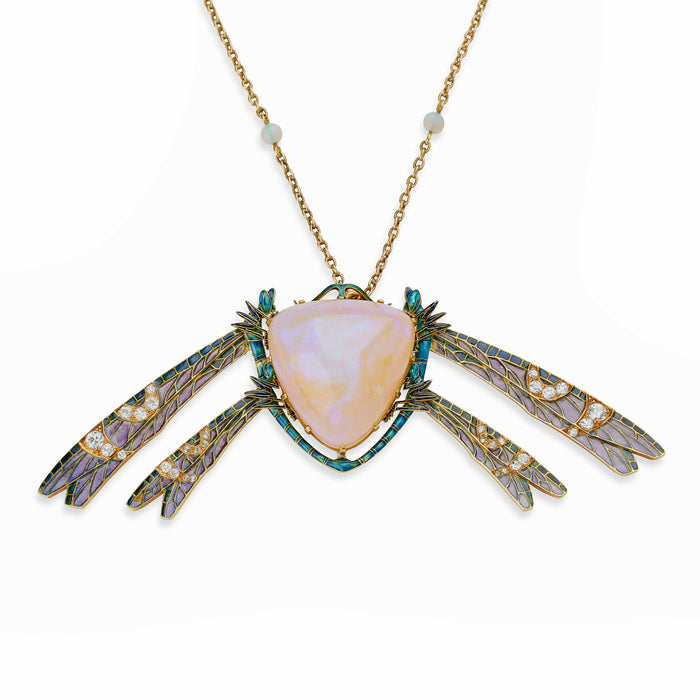
René Lalique Art Nouveau Plique-à-jour Enamel, Fire Opal and Diamond Damselfly "Demoiselles" Pendant
$155,000
Created circa 1900-1902, this damselfly pendant necklace by René Lalique is composed of plique-à-jour, pailonné, and champlevé enamel, fire opal, diamonds and 18K gold. It is designed as four damselflies with champlevé and plique-à-jour enamel wings, in shades of lavender and indigo, with touches of green, highlighted by old European and old mine-cut diamonds,joining slender opalescent blue pailloné (foiled) enamel bodies, the reverse with elaborate chased designs, roosting on a fire opal cabochon, suspended from a later trace link chain punctuated by opal beads. A masterful study in challenging enamel techniques, this rare jewel summons a mood of beauty, peace and evanescence in nature.
- Product Details
- Curator's Notes
Item #: N-21371
Artist: René Lalique
Country: France
Circa: 1900-1902
Dimensions: 1.50" length, 3.75" width.
Materials: 30 old European-cut diamonds (approximate total weight 0.70 carat); 1 cabochon fire opal; Plique-à-jour, Paillonné and Champlevé Enamel; 18K Gold
Signed: LALIQUE
Exhibition History: A dragonfly necklace employing a similar combination of plique-à-jour, pailonné, and champlevé enamel is held in the collection of the Musée Orsay (OAO 898) and is on view there.
Literature: An elaborate damselflies necklace with wings of similar design dated circa 1900-1902 is pictured in The Master Jewelers, Kenneth Snowman, ed., p. 133.
Though the artist is often connected with the master enameler Eugène Feuillâtre, it is most likely that Lalique accomplished his feats of enameling in his own workshop. His collaborator in gold "chiseling" as well as a draftsman who "finished" technical sketches for some designs, are both documented, but no evidence tying Lalique outside enamelists has been found. In fact, according to Sigrid Barten, author of the the catalogue raisonné of Lalique's jewelry, everything indicates that, with minor exceptions, Lalique "dominated in this area."
The exuberant display of accomplished enameling and the gem material suggest this jewel dates from 1900-1902. At that time Lalique was also experimenting with opals, a gem avoided by other jewelers for its long association with ill luck, and the technical difficulty of cutting it. The large and unusual fire opal, with its mysterious lilac play-of-color, relates to opals set in the extraordinary Symbolist-themed necklace (designed for his second wife) in the collection of the Metropolitan Museum of Art. Lalique designed jewels during this period, such as the wasp hair pin shown at the 1900 Paris Exposition, and the wooded landscape dog collar, set against a opal lake, in which he employed opals carved in a novel and creative manner to represent pollen-laden blossoms and turbulent water. Similar in size and base color to the cabochons of the Met's necklace, this opal was chosen for its more definite orange glow, possibly to create an ambiance of sunset. The three enameling techniques serve to increase the visual and textural complexity of the damselflies, beautifully evoking not only the fragility and luminescence of their wings, but the metallic iridescence of their delicate shelled bodies. The color scheme of the jewel represents an unusually broad range of spectral hues for Lalique, with enamels from green to blue to indigo to violet, combined with the opal of strong orange and yellow base tones and billowy violet phenomenon.
An important aspect of Lalique's development as an artist involved his study of Japanese art in association with promoters such as Siegfried Bing, starting in 1895. This tiny composition exuding reverence for nature embodies why Lalique is termed a Japonesque "master of atmosphere". Designed with an economy of line, representing a "fragment of the whole", the jewel conjures a vanishing moment in the sylvan world of streams, lakes and water meadows at dawn or dusk.

